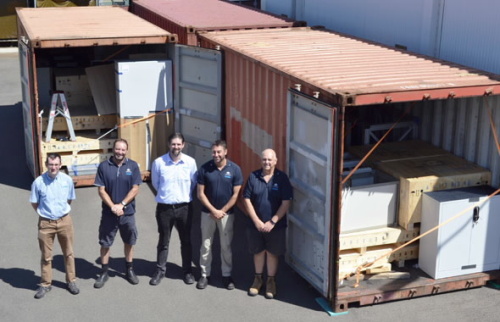Neutron instrument BioRef arrived safely in Down Under

The SPATZ team of ANSTO was glad about the arrival of the former HZB neutron instrument BioRef. It will be set up until 2018 in Australia. photo: ANSTO.
As reported, the neutron instrument BioRef will be set up at the “Australian Centre for Neutron Scattering” of ANSTO. Approximately 257 components were safely packed in 43 wooden crates weighing just under 30 tonnes for the sea voyage from Hamburg to Port Botany, Australia. On 14 February the colleagues from ANSTO told us: the three shipping containers arrived safely after a two-month journey from Germany.
The ship transporting the packaged crates stopped at seven ports on the 45-day voyage which covered over 11,800 nautical miles.
The ship transporting the packaged crates stopped at seven ports on the 45-day voyage which covered over 11,800 nautical miles. - See more at: http://www.ansto.gov.au/AboutANSTO/MediaCentre/News/ACS124610#sthash.WLX9dQNg.bL2NpYAE.dpuf
ANSTO and HZB negotiated the transfer of the instrument from the BER-II Research Reactor at Helmholtz-Zentrum Berlin (HZB) and renewed a MOU for scientific collaboration with the renowned German research organisation in 2016. The instrument will be set up at the Australian Centre for Neutron Scattering (ACNS) until 2018. The new name is SPATZ, the German word for sparrow. It follows the tradition of the naming convention of other instruments at the Australian Centre for Neutron Scattering, which are named after Australian and other fauna. SPATZ will be available for user from Germany, too.
Read more here
(sz)
https://www.helmholtz-berlin.de/pubbin/news_seite?nid=14620;sprache=en
- Copy link
-
Bright prospects for tin perovskite solar cells
Perovskite solar cells are widely regarded as the next generation photovoltaic technology. However, they are not yet stable enough in the long term for widespread commercial use. One reason for this is migrating ions, which cause degradation of the semiconducting material over time. A team from HZB and the University of Potsdam has now investigated the ion density in four different, widely used perovskite compounds and discovered significant differences. Tin perovskite semiconductors produced with an alternative solvent had a particular low ion density — only one tenth that of lead perovskite semiconductors. This suggests that tin-based perovskites could be used to make solar cells that are not only really environmentally friendly but also very stable.
-
Synchrotron radiation sources: toolboxes for quantum technologies
Synchrotron radiation sources generate highly brilliant light pulses, ranging from infrared to hard X-rays, which can be used to gain deep insights into complex materials. An international team has now published an overview on synchrotron methods for the further development of quantum materials and technologies in the journal Advanced Functional Materials: Using concrete examples, they show how these unique tools can help to unlock the potential of quantum technologies such as quantum computing, overcome production barriers and pave the way for future breakthroughs.
-
How carbonates influence CO2-to-fuel conversion
Researchers from the Helmholtz Zentrum Berlin (HZB) and the Fritz Haber Institute of the Max Planck Society (FHI) have uncovered how carbonate molecules affect the conversion of CO
2 into valuable fuels on gold electrocatalysts. Their findings reveal key molecular mechanisms in CO
2 electrocatalysis and hydrogen evolution, pointing to new strategies for improving energy efficiency and reaction selectivity.
